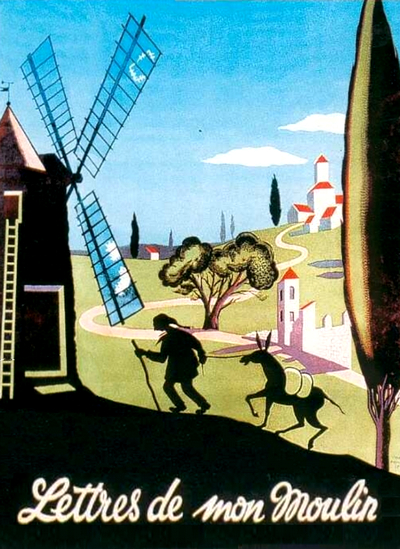Letters From My Windmill
Letters from my mill (French Lettres de mon Moulin ) is a collection of tales of the French writer Alphonse Daudet ( 1840-1897 ), which was first published in 1869 in book form.
Genesis
The first twelve letters appeared from August to November 1866 in the newspaper L' Evénement; more narratives followed from October 1868 to October 1869 in Le Figaro. The first edition with some changes was released in late 1869 in the Hetzel -Verlag. In the final edition of 1879 a further six stories were added.
Some of the letters were created in collaboration with Paul Arene. Journalist and author Octave Mirbeau accused of plagiarism Daudet why, but Arene even rejected all accusations and doubts as to the authorship of Daudet: "Your mill! for the mill belongs to you, undisputed, and if we also have to second- placed the purchase agreement [ ... ]. " The first letters were under the pseudonym '' Marie- Gaston '' appeared ( Gaston Paul Arene ), from the sixth letter Daudet, signed with his name.
Content
At the beginning of the book Daudet describes his entry into the abandoned for over twenty years and wind corn mill in the Rhone Valley "in the heart of Provence ." From there he directed his letters to the reader in the " noisy, black " Paris. Three stories are set in Algeria, where Daudet had spent the winter of 1861 /62. In two letters to process the impressions and memories of his stay in Corsica in the following year; the scene of the other stories is the Provence. Daudet describes cheerful and ironic everyday events ( The Old ), Provencal farces ( The Elixir of Father Gaucher Reverend ), stories in the style of folk tales ( Mr. Seguin goat), but also tragic events such as the sinking of the frigate Semillante.
- Statement (Avant - propos )
- Catchment (Installation)
- The stagecoach from Beaucaire ( La Diligence de Beaucaire )
- Cornilles master secret ( Le Secret de maître Cornille )
- Mr. Seguin Goat ( La Chèvre de monsieur Seguin )
- The Stars ( Les Stars )
- The Arlesierin (L' Arlesienne )
- The mule of the Pope (La Mule du pape )
- The lighthouse of sanguinaires Islands (Le Phare des sanguinaires )
- The death throes of the " Semillante " (L' agony de la " Semillante " )
- The publican (Les Douaniers )
- The pastor of Cucugnan (Le Curé de Cucugnan )
- The ancients (Les Vieux )
- Ballads in prose ( Ballades en Prose )
- Bixious wallet (Le Portfolio de Bixiou )
- The Legend of the Man with the Golden Brain (La Légende de l' Homme à la Cervelle d'or )
- The poet Mistral (Le Mistral Poète )
- The three silent Fairs ( Les trois Messes basses )
- The Oranges ( Les Oranges )
- The two public houses (Les deux Auberges )
- In Miliana (A Milianah )
- The Locusts (Les Sauterelles )
- The Elixir of Father Gaucher reverend (L' Élixir you Révérend Père Gaucher )
- In the Camargue (En Camargue )
- Homesick for the barracks ( Nostalgies de barracks )
Background
- On a hill south of the village Fontvieille is the mill was built in 1814 ( whose reconstruction respectively), which was Daudet inspiration and an example. He described it as " ruin [... ] a decaying wreck of stone, iron and old boards that had not placed under wind for years. " Today it bears the name of the writer and houses a small museum.
- The described in the letters of the purchase and collection are fictitious. Alphonse Daudet - never lived in the mill and was never the owner - contrary to the legend. The letters written by the native Provencale in Clamart and Paris.
- Daudet drew up a stage version of the story The Arlesierin; the world premiere of the play in 1872 was a failure. Georges Bizet wrote incidental music to which he then instrumented to L' Arlesienne Suite No.1 for orchestra.
- 1954 was the French- language film Lettres de mon moulin, directed by Marcel Pagnol, who also wrote the script to do so. The three were filmed silent Measure, The Elixir of the Reverend Father Gaucher and master Cornilles secret.









